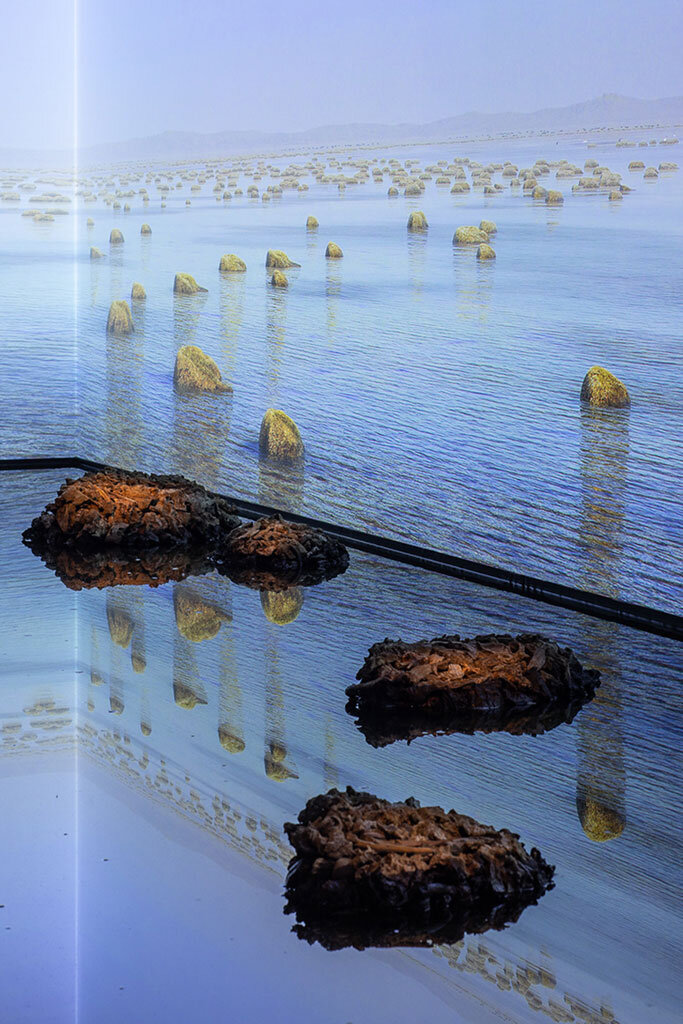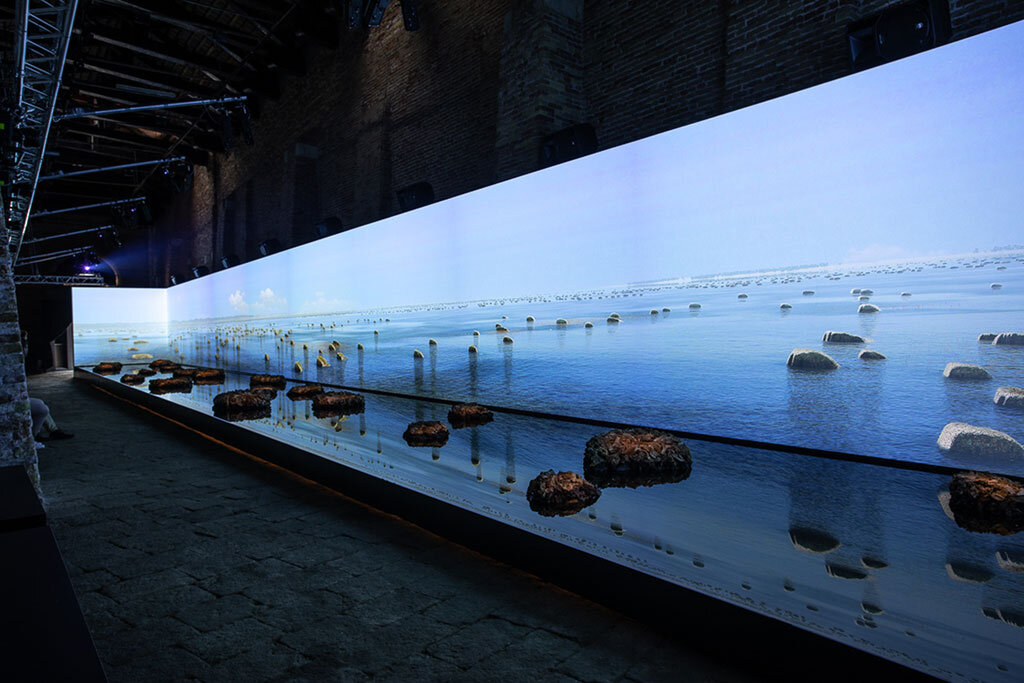Living Rocks: A Fragment of the Universe, 2019
58th International Art Exhibition – La Biennale di Venezia, Venice, Italy
James Darling & Lesley Forwood, Living Rocks: A Fragment of the Universe, 2019, digital video, 1.5 tonnes Mallee root & 4,000 litres of water, 37 x 3 m, at Magazinni de Sale.
Addressing the question: what was our planet three billion years ago? the installation Living Rocks: A Fragment of the Universe is a South Australian collaboration by artists James Darling and Lesley Forwood, Jumpgate, composer Paul Stanhope, the Australian String Quartet and presented by The Art Gallery of South Australia.
In Living Rocks, water floods the Magazzini del Sale, the historic stone salt storehouses of Venice that have stood the test of many an inundation. From an extensive pool emerge thrombolites that have been crafted, not by unimaginable time and the force of nature, but by the artists who employ the distinctive roots of an arid land eucalypt to create living rocks.
The installation connects the present day to the beginning of life. It is a memory of our origin and a prophesy of our future.
- James Darling, Artist
Living Rocks: A Fragment of the Universe has been selected as one of only 21 official collateral events of the Biennale Arte 2019 in Venice.
Curator
Dr Lisa Slade
Official Collateral Event
58th International Art Exhibition – La Biennale di Venezia
Press Release
James Darling and Lesley Forwood’s monumental installation, Living Rocks: A Fragment of the Universe is on display until 24 November 2019 at the Magazinni de Sale for the 58th International Art Exhibition – La Biennale di Venezia. Living Rocks is the first ever solo Australian project to be selected as an Official Collateral Event in La Biennale Arte and one of only 21 such events selected. Living Rocks has attracted an average of 500 visitors a day and is an exemplar work from two of the greatest land artists alive today.
Living Rocks is a feat of both artistic merit and exceptional coordination between multiple organisational bodies. Three tonnes of arid eucalypt stumps have been shipped to Venice and positioned in a huge pool of water to re-create the geological marvels, thrombolites, at the Magazinni de Sale, Venice's old salt emporium.
"Living Rocks celebrates the physical presence of thrombolites. It celebrates microbial life. Looking back and looking forward, the concept of microbialites as the ‘disaster-recovery’ or default ecosystem of our planet, and perhaps of many others, speaks of genius and genesis.”
- James Darling, Artist
The shallow 30-metre-long pool (engineered by South Australian engineer Rob Cooper), containing thousands of litres of water, comes within 5 centimetres of the 37metre x 3 metre digital screen projecting a 20 minute moving image displaying a span of 3 billion years. Ten 4K projectors provide this moving image, rendered in 26K (which was a challenge to facilitate as films are typically rendered in 2K or 4K). The ten 4K projectors were required in order for the projection to be experienced in 3D, and so the VR projections do not require headgear to be experienced.
“Creating a scene in 26K has immense challenges, the software can’t deal with it. So, we’ve had to innovate on the back-end to make sure we can live up to the expectations of the artists. This includes the rendering and the 3D program where we’re creating these digital worlds. We used an artificial intelligence up-scaler to take it from 13K to 26K, but it was going too slow so we re-wrote a new AI up-scaler so we were able to deal with this.”
- Jumpgate VR Managing Director Anton Andreacchio
As well as spurring on this VR technology innovation, Living Rocks has also brought together leading scientists in the creation of this significant work. Leading scientists Professor Dr Robert Burne, Emeritus Professor of Earth & Environmental Science at the Australian National University, and Professor Malcolm Walter AM, FAA, Emeritus Professor of Astrobiology School of Biological, Earth and Environmental Sciences, University NSW have been advisors to the artists throughout this project. Living Rocks is also accompanied by leading Australian composer Paul Stanhope’s String Quartet No 2, performed by the internationally-acclaimed Australian String Quartet – incidentally based at the Elder Conservatorium of Music at the University of Adelaide- and recorded at the UKARIA Cultural Centre in Mount Barker, South Australia.
Living Rocks: A Fragment of the Universe is both a testament to the world-class industries and organisations operating in South Australia, and the exceptional results generated from cross-disciplinary collaboration
This project has been achieved in collaboration with:
Jumpgate VR
Anton Andreacchio: Managing Director
Piers Mussared, Carlo Andreacchio, Edward Watson
The Australian String Quartet
Composer: Paul Stanhope, String Quartet No 2 III. Dirge (Variations)
Commissioned for Musica Viva Australia by Kim Williams AM for the Pavel Haas String Quartet
Performed by the Australian String Quartet
Dale Barltrop – Violin I
Francesca Hiew – Violin II
Stephen King – Viola
Sharon Grigoryan – Cello
Used with permission by Paul Stanhope and the Australian String Quartet.
Copyright Australian String Quartet 2019
The ASQ is Quartet-in-Residence at the University of Adelaide, Elder Conservatorium and greatly values the support of its current sponsors and supporters.
Recorded at UKARIA Cultural Centre, Mt Barker, South Australia – December 2017
Stephen Snelleman – Producer
Russell Thomson – Engineer
Alex Stinson – Editing and Mastering
Art Gallery of South Australia
Curator: Lisa Slade
Distinctive Gardens
Rob Cooper
enquiries@distinctivegardens.com.au
Venice Art Factory
Luca Berta
Freddy Komp
With Thanks:
Professor Dr Robert Burne
Emeritus Professor School of Earth and Environmental Science at The Australian National University
Professor Malcolm Walter AM, FAA
Emeritus Professor of Astrobiology School of Biological, Earth & Environmental Sciences
University of New South Wales, Sydney
This project has been assisted by the Australian Government through the Australia Council, its arts funding and advisory body










